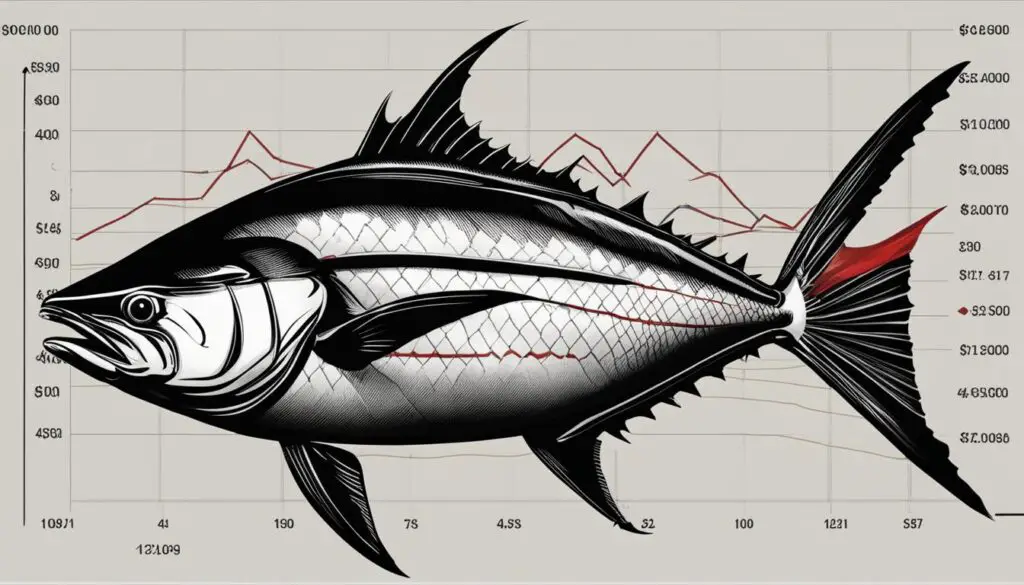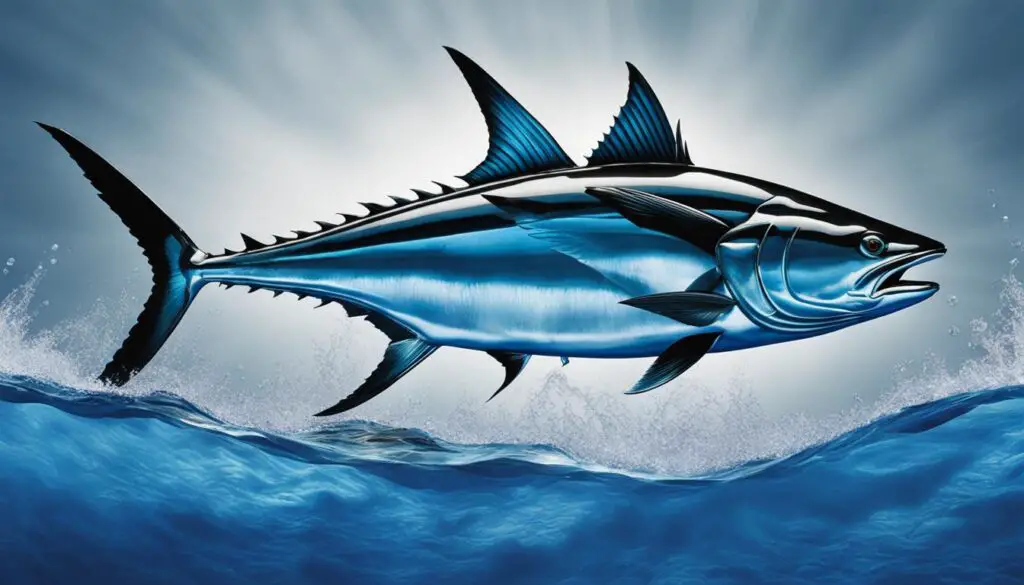Bluefin tuna is often considered the Rolls Royce of seafood, highly prized in the industry. But just how much does this coveted fish sell for? Let’s dive into the world of bluefin tuna pricing to uncover the secrets behind its market value.
Key Takeaways:
- The price of bluefin tuna varies depending on factors such as source, sustainability, and quality.
- Bluefin tuna auctions in Japan have seen prices as high as $3 million for a 612-pound fish.
- The cost of bluefin tuna is influenced by factors such as overfishing, inability to breed in captivity, Japanese butchering expertise, and size differences compared to other tuna species.
- The sustainability and traceability of bluefin tuna can affect its market value.
- Bluefin tuna is known for its exceptional quality and different varieties offer distinct flavors and textures.
Factors Affecting Bluefin Tuna Prices
The market price of bluefin tuna is influenced by several key factors. These factors determine the cost of this highly sought-after seafood and contribute to its overall value. Understanding these factors can help us delve deeper into the dynamics of the bluefin tuna market.
The Role of Overfishing
Overfishing has had a significant impact on the scarcity and subsequent price of bluefin tuna. Bluefin tuna are slow-growing and cannot be bred in captivity, making them vulnerable to overfishing. As a result, the supply of bluefin tuna has been greatly reduced, driving up their market price.
Japanese Butchering Expertise
Japanese expertise in butchering and processing bluefin tuna adds to its cost. Some fish are sent to Japan for their butchering techniques and then exported back to their destination. This process ensures the highest quality cuts of bluefin tuna, which commands a premium price in the market.
Size and Weight
Bluefin tuna are known for their large size and weight compared to other tuna species. This size difference impacts the price, as larger fish often command a higher value. The weight of bluefin tuna directly affects the quantity and quality of meat available, making it a crucial factor in determining the overall price.
These factors, among others, contribute to the complex pricing structure of bluefin tuna in the market. Understanding these dynamics helps us appreciate the value and unique characteristics of this prized seafood.
Sustainability and Traceability of Bluefin Tuna
When considering the value of bluefin tuna, sustainability and traceability are crucial factors to take into account. Efforts have been made to improve the sustainability of bluefin tuna stocks through the implementation of recovery plans and conservation measures. These initiatives aim to protect bluefin tuna populations and ensure their long-term viability, which can ultimately impact the market value of this prized fish.
Knowing the source of the bluefin tuna and having transparent traceability is essential in guaranteeing the best quality. Consumers are increasingly concerned about the ethical and environmental considerations surrounding their seafood choices. Purchasing bluefin tuna from sustainable sources may come at a higher average price, but it provides peace of mind and supports responsible fishing practices.
The average price of bluefin tuna can vary depending on factors such as the source, seasonality, and demand. Locally, bluefin tuna can range from $20 to $40 per pound, while the market value can fluctuate based on various market forces. Transparent and sustainable sourcing contributes to the overall value of bluefin tuna, ensuring that consumers can enjoy this delicacy with confidence.
Quality and Varieties of Bluefin Tuna
Bluefin tuna is renowned for its exceptional quality and is highly sought after in the culinary world. With its buttery texture and rich flavor, bluefin tuna is often exported to Japan for its premium cuts, particularly for sushi and sashimi. The different varieties of bluefin tuna offer distinct flavors and textures, providing a diverse range of options for seafood enthusiasts.

The grading system for bluefin tuna categorizes the fish based on color, clarity, and suitability for different dishes. Grade #1 tuna, with its bright red color and extra clarity, is perfect for sashimi. Grade #2, which has a slight loss of color and clarity, is ideal for dishes like poke bowls. Grade #3, with its more opaque appearance, is well-suited for grilling. Each grade offers a unique culinary experience, allowing chefs and consumers to explore the diversity of flavors and preparations that bluefin tuna has to offer.
Bluefin tuna auctions in Japan are renowned for their high prices, often reaching millions of dollars for the first fish sold. These auctions signify the prestige and value associated with this prized fish. The demand for bluefin tuna, its unique qualities, and the expertise required to handle and process it contribute to the high auction prices observed in the market.
The Economics of Bluefin Tuna
Bluefin tuna is not only a prized delicacy but also a valuable commodity in the seafood market. Its market price is influenced by various economic factors that contribute to its supply and demand dynamics.
As one of the most sought-after fish in the culinary world, bluefin tuna commands a high price due to its scarcity. Overfishing has significantly depleted bluefin tuna stocks, making it a limited resource. The laws of supply and demand dictate that as the supply decreases, the price increases. This scarcity factor drives up the market price of bluefin tuna.
Furthermore, the cultural significance of bluefin tuna in Japan plays a significant role in its market pricing. In Japan, bluefin tuna is considered a luxury item and often served in high-end sushi restaurants. The demand for bluefin tuna remains consistently high, with discerning consumers and businesses willing to pay a premium for this prized fish.
Factors Influencing the Selling Price
“The price of bluefin tuna is determined by factors such as scarcity, cultural demand, and transportation costs.”
- Scarcity: Overfishing has led to a decline in bluefin tuna populations, resulting in limited supply and increased market prices.
- Cultural Demand: Bluefin tuna holds a special place in Japanese cuisine and culture, driving up its demand and market value.
- Transportation Costs: The transportation of bluefin tuna from the source to the market can add to its overall selling price, particularly when it comes to shipping to Japan for processing and then back to other destinations.
While the economics of bluefin tuna pricing can be complex, it ultimately boils down to the delicate balance between supply, demand, and cultural significance. As long as bluefin tuna remains a highly coveted culinary delicacy, its market price is likely to remain at a premium level.
The Taste and Experience of Bluefin Tuna
Bluefin tuna offers a mesmerizing taste and a culinary experience like no other. With its rich, buttery flavor and exceptional marbling, this prized fish is highly sought after in the seafood world. Its unique characteristics make it a favorite choice for sushi and sashimi, creating a melt-in-your-mouth sensation that leaves a lasting impression.
Described as exquisite, balanced, and succulent, bluefin tuna captivates the palate with its savory and buttery sweet notes. The high fat content of the fish enhances its flavor, creating a luxurious taste experience that seafood enthusiasts crave. Whether enjoyed in traditional nigiri, sashimi slices, or creative culinary creations, bluefin tuna delights with its unmatched texture and umami profile.
Bluefin tuna’s premium quality and exceptional taste justify its higher market price compared to other fish. Its reputation as a delicacy is further strengthened by the variety of cuts it offers. From bright red grade #1 pieces, perfect for sashimi, to more opaque grade #3 cuts ideal for grilling, there is a bluefin tuna option for every culinary preference. The versatility of this fish allows chefs and home cooks alike to explore its flavors in a myriad of dishes, ensuring a truly memorable gastronomic experience.

Bluefin Tuna: A Culinary Delight
“Bluefin tuna provides a heavenly taste and texture that is simply unmatched. Its exceptional quality and unique flavor profile make it a luxurious indulgence for seafood lovers.”
The taste and experience of bluefin tuna justify its higher market price, as it offers a remarkable dining adventure that appeals to discerning palates. Its distinct combination of flavors, textures, and culinary possibilities elevates any meal to a gourmet level. Bluefin tuna truly stands as a symbol of excellence in the seafood world, ensuring an unforgettable dining experience for all who savor its exquisite taste.
The Role of Sustainability in Bluefin Tuna Pricing
Sustainability plays a crucial role in determining the price of bluefin tuna. With concerns over overfishing and the depletion of bluefin tuna stocks, conservation efforts have been put in place to protect the species and ensure its long-term viability. These efforts have led to the implementation of recovery plans, such as the 15-year plan initiated in 2007, which has resulted in a reduction in sanctioned catch and quotas. By prioritizing sustainability, the market value of bluefin tuna is influenced, as responsible sourcing and transparent traceability are highly valued by consumers.
Choosing to purchase bluefin tuna from sustainable sources may come at a higher price, but it provides peace of mind in terms of ethical and environmental considerations. By supporting sustainable fishing practices, consumers can contribute to the preservation of bluefin tuna populations and the health of our oceans. Additionally, the market demand for sustainably sourced seafood continues to grow, as more individuals and businesses prioritize sustainability in their purchasing decisions.
As the industry continues to evolve, sustainability is likely to play an even greater role in determining the pricing of bluefin tuna. With ongoing efforts to address overfishing and promote sustainable fishing practices, the availability and market price of bluefin tuna may be influenced in the coming years. By supporting sustainable sources and conscientious suppliers, consumers can contribute to the long-term sustainability of bluefin tuna and help shape the future of its pricing.
The Future of Bluefin Tuna Pricing
The future of bluefin tuna pricing is uncertain and subject to various factors. Continued efforts to address overfishing and promote sustainable fishing practices will play a significant role in determining the availability and market price of bluefin tuna. As global fishing regulations evolve and consumer preferences shift towards sustainable options, the pricing and availability of bluefin tuna may be influenced in the coming years.
Overfishing and scarcity contribute to the higher market prices, as demand remains high for this prized fish. The cultural significance of bluefin tuna in Japan also has an impact on its market price, as it is considered a luxury and highly sought-after item. The cost of transportation, including shipping to Japan for processing and then back to other destinations, adds to the overall price of bluefin tuna.
The future of bluefin tuna pricing will also depend on the success of sustainability measures aimed at protecting bluefin tuna populations. Efforts to improve traceability and ensure responsible sourcing can help maintain the market value of bluefin tuna. Consumers’ increasing awareness and preference for sustainable options may drive demand for ethically sourced bluefin tuna, potentially affecting its pricing in the future.
Factors influencing the future pricing of bluefin tuna:
- Continued efforts to address overfishing and promote sustainable fishing practices
- Regulations and policies on global fishing practices
- Consumer demand for sustainable seafood
- Availability of alternative seafood options
- Economic factors, including transportation costs and currency exchange rates
As the future unfolds, the pricing and availability of bluefin tuna will continue to be shaped by these and other factors. Whether it remains a luxury delicacy or becomes more accessible to a wider market will depend on the industry’s commitment to sustainability and the willingness of consumers to embrace responsible seafood choices.

Bluefin Tuna as a Luxury Experience
When it comes to seafood, few things can compare to the luxurious experience of indulging in bluefin tuna. Highly prized for its exceptional quality and exquisite taste, bluefin tuna is often regarded as the Rolls Royce of the seafood world. Its rich and buttery flavor, coupled with its melt-in-your-mouth texture, sets it apart from other types of fish.
While the average price of bluefin tuna may be higher compared to other fish, its status as a delicacy makes it a worthwhile investment for culinary enthusiasts. Whether enjoyed as sushi, sashimi, or in other gourmet dishes, bluefin tuna offers a range of flavors and textures that cater to the most discerning palates.
Bluefin tuna auctions in Japan frequently see high auction prices, with the first fish sold often fetching millions of dollars. This tradition speaks to the cultural significance and reverence for bluefin tuna in the Japanese culinary landscape.

The Average Price of Bluefin Tuna
Bluefin tuna prices can vary depending on factors such as sourcing, processing, and demand. Locally sourced bluefin tuna can range from $20 to $40 per pound, while specialty varieties like Oma tuna can cost up to $400 per pound. The cost of bluefin tuna reflects its luxury status and the meticulous care and expertise required to catch, handle, and process this prized fish.
Bluefin tuna is associated with high quality, exquisite taste, and premium dining experiences.
While the price of bluefin tuna may be considered high, the experience it offers is unparalleled. From its superior taste and texture to the meticulous craftsmanship required to bring this delicacy to the table, bluefin tuna truly embodies the epitome of luxury in the world of seafood.
Choosing a Reliable Source for Bluefin Tuna
When it comes to purchasing bluefin tuna, it is crucial to select a reliable source that prioritizes quality and sustainability. The market value of bluefin tuna is influenced by factors such as sourcing, handling practices, and transparency in traceability. To ensure you are getting the freshest and most ethically caught bluefin tuna, it is essential to work with a trusted supplier who shares your commitment to excellence.
At Bluefiná, we take pride in being a leading supplier of bluefin tuna, offering a reliable source for high-quality fish that meets the stringent standards of discerning clients. Our focus on sustainability means that our bluefin tuna is ethically and sustainably caught, preserving the species for future generations. We prioritize transparency in traceability, providing you with detailed information about the origin, age, and handling practices of our bluefin tuna.
With expertise in handling, butchering, and processing bluefin tuna, we guarantee exceptional freshness and flavor in every bite. Our commitment to sustainability, ethical practices, and exceptional taste sets us apart in the bluefin tuna market. Contact Bluefiná today to experience the luxury and quality of our bluefin tuna and elevate your culinary creations.
Bluefiná – Your Trusted Source for Bluefin Tuna
Looking for a reliable and top-quality source for bluefin tuna? Look no further than Bluefiná! As a leading supplier in the industry, Bluefiná offers the finest and most sustainable bluefin tuna on the market.
At Bluefiná, we understand the importance of freshness, quality, and transparency. That’s why we prioritize natural feeding and sustainable fishing practices to ensure the highest standards for our bluefin tuna. Our commitment to ethical sourcing and transparent traceability guarantees that you’re getting the best product with every purchase.
When you choose Bluefiná, you’re not only getting exceptional bluefin tuna, but also partnering with a company that shares your values. Our expertise in handling and processing bluefin tuna sets us apart, making us the preferred choice for sushi chefs and seafood enthusiasts worldwide.
Experience the luxury and unmatched quality of Bluefiná’s bluefin tuna. Contact us today to discover the market price and value of our premium bluefin tuna, and let us provide you with the best seafood experience possible!
FAQ
How much do bluefin tuna sell for?
The price of bluefin tuna can vary depending on factors such as the source, sustainability, and quality. Bluefin tuna auctions in Japan have seen prices as high as $3 million for a 612-pound fish, although wholesale prices are significantly lower. Bluefin tuna from Japan can range from $20 to $40 per pound locally, while specialty varieties like Oma tuna can cost up to $400 per pound.
What factors affect bluefin tuna prices?
The price of bluefin tuna is influenced by factors such as overfishing, the inability to breed in captivity, Japanese butchering expertise, and size differences compared to other tuna species. Overfishing has contributed to the scarcity of bluefin tuna, driving up the prices. Japanese expertise in butchering and processing bluefin tuna also adds to the cost, as some fish are sent to Japan for processing and then returned to their destination. The size of bluefin tuna, with their larger weight compared to other tuna species, also impacts the price.
What is the average price of bluefin tuna?
The average price of bluefin tuna can range from $20 to $40 per pound locally, depending on the source and quality. The market value can vary based on factors such as seasonality and demand.
What are the different varieties and grades of bluefin tuna?
Bluefin tuna comes in different varieties such as akami, toro (including chutoro and otoro), each offering distinct flavors and textures. Grade #1 tuna is bright red and extra clear, perfect for sashimi. Grade #2 has a slight loss of color and clarity, suitable for dishes like poke bowls. Grade #3 is more opaque and ideal for grilling.
What impact does sustainability have on bluefin tuna pricing?
The sustainability and traceability of bluefin tuna can affect its market value. Efforts have been made to improve the sustainability of bluefin tuna stocks, with the implementation of a 15-year recovery plan starting in 2007. The average price of bluefin tuna can be influenced by responsible sourcing and transparent traceability, as consumers value ethical and environmentally friendly options.
What does the future hold for bluefin tuna pricing?
The future of bluefin tuna pricing is uncertain and subject to various factors. Continued efforts to address overfishing and promote sustainable fishing practices will play a significant role in determining the availability and market price of bluefin tuna. The demand for high-quality seafood, including bluefin tuna, is expected to continue.
Is bluefin tuna considered a luxury experience?
Yes, bluefin tuna is often regarded as a luxury experience in the world of seafood. It is associated with high quality, exquisite taste, and premium dining experiences. While the average price of bluefin tuna may be higher compared to other fish, its status as a delicacy makes it a worthwhile investment for culinary enthusiasts.
How can I choose a reliable source for bluefin tuna?
When purchasing bluefin tuna, it is essential to choose a reliable source that prioritizes quality and sustainability. Look for suppliers that offer transparent traceability and knowledge of the fish’s origin, age, and handling practices. Working with a trusted supplier can guarantee the highest quality bluefin tuna that meets the standards of discerning consumers and businesses in the seafood industry.
Where can I find a trusted source for bluefin tuna?
Bluefiná is a leading supplier of bluefin tuna, offering a reliable source for high-quality and sustainably sourced fish. With a focus on freshness, natural feeding, and transparent traceability, Bluefiná ensures that their bluefin tuna meets the highest standards of discerning clients. Contact Bluefiná today to experience the luxury and quality of their bluefin tuna.

